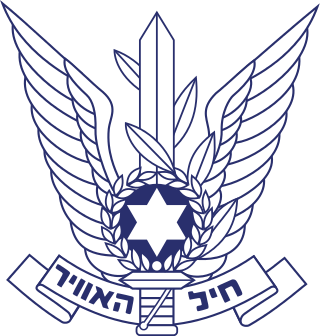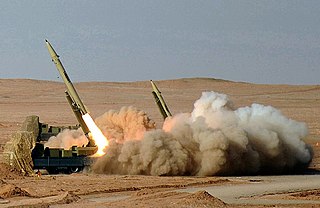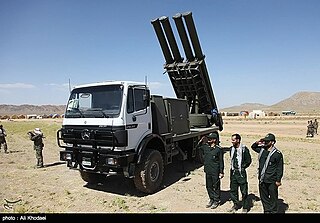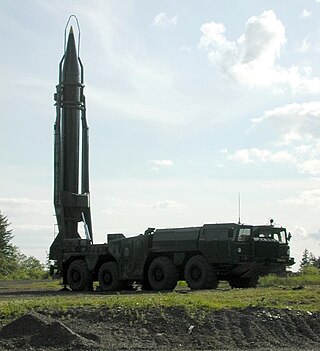
A ballistic missile (BM) is a type of missile that uses projectile motion to deliver warheads on a target. These weapons are powered only during relatively brief periods—most of the flight is unpowered. Short-range ballistic missiles (SRBM) typically stay within the Earth's atmosphere, while most larger missiles are exo-atmospheric. The largest ICBMs are capable of full orbital flight. These weapons are in a distinct category from cruise missiles, which are aerodynamically guided in powered flight and thus restricted to the atmosphere.

The Israeli Air Force operates as the aerial and space warfare branch of the Israel Defense Forces (IDF). It was founded on May 28, 1948, shortly after the Israeli Declaration of Independence. As of April 2022, Aluf Tomer Bar has been serving as the Air Force commander.

The relations between Iran and Israel are divided into four major phases: the ambivalent period from 1947 to 1953, the friendly period during the era of the Pahlavi dynasty from 1953 to 1979, the worsening period following the Iranian Revolution from 1979 to 1990, and the ongoing period of open hostility since the end of the Gulf War in 1991. In 1947, Iran was among 13 countries that voted against the United Nations Partition Plan for the British Mandate of Palestine. Two years later, Iran also voted against Israel's admission to the United Nations.

The Fateh-110, also known as NP-110 is an Iranian solid-fueled surface-to-surface ballistic missile produced by Iran's Aerospace Industries Organization since 2002. It is single-stage, road-mobile and can carry a high-explosive warhead of up to 500 kg. Four different versions, the Fateh-110A, 110B, 110D-1 and Fateh-E Mobin were developed with varying accuracy. The latest version, first shown to the public in August 2018 reportedly has a range of 300 km is reportedly more accurate than previous versions.

The Fajr-3 is an Iranian heavy 240 mm intermediate-range multiple-launch artillery rocket (MLRS). The Fajr-3 is a license-built copy, with slight modifications, of a North Korean MLRS called the M-1985. The Fajr-3 was introduced in the 1990s and has since been exported to Hamas and Hezbollah.

The Fajr-5 is an Iranian 333 mm long-range multiple launch rocket system (MLRS). The Fajr-5 was developed during the 1990s and has since been exported to various armed actors in the Middle East.

Hezbollah, a Lebanese Shia Islamist political party and militant group, has an exceptionally strong military wing, thought to be stronger than the Lebanese Army, and equivalent to the armed strength of a medium-sized army. A hybrid force, the group maintains "robust conventional and unconventional military capabilities", and is generally considered to be the most powerful non-state actor in the world.

A Scud missile is one of a series of tactical ballistic missiles developed by the Soviet Union during the Cold War. It was exported widely to both Second and Third World countries. The term comes from the NATO reporting name attached to the missile by Western intelligence agencies. The Russian names for the missile are the R-11, and the R-17Elbrus. The name Scud has been widely used to refer to these missiles and the wide variety of derivative variants developed in other countries based on the Soviet design.

The History of the Israel Air Force begins in May 1948, shortly after the formation of the State of Israel. Following Israel's declaration of independence on May 14, its pre-state national institutions transformed into the agencies of a state, and on May 26, 1948, the Israeli Air Force was formed. Beginning with a small collection of light aircraft, the force soon transformed into a comprehensive fighting force. It has since participated in several wars and numerous engagements, becoming what has been described as "The mightiest air force in the Middle East".

The January 2013 Rif Dimashq airstrike was an aerial attack in the Rif Dimashq Governorate of Syria, which targeted a convoy alleged to be carrying weapons from Syria to the Lebanese Shi'a militia Hezbollah. The convoy was attacked on 31 January 2013. According to several media sources, Israeli forces allegedly conducted the strike, however Israel hasn't officially responded to the allegations.
The following is a timeline of the Syrian civil war from May to December 2013. Information about aggregated casualty counts is found at Casualties of the Syrian Civil War.

The Iran–Israel proxy conflict, also known as the Iran–Israel proxy war or Iran–Israel Cold War, is an ongoing proxy conflict between Iran and Israel. In the Israeli–Lebanese conflict, Iran has supported Lebanese Shia militias, most notably Hezbollah. In the Israeli-Palestinian conflict, Iran has backed Palestinian groups such as Hamas. Israel has supported Iranian rebels, such as the People's Mujahedin of Iran, conducted airstrikes against Iranian allies in Syria and assassinated Iranian nuclear scientists. In 2018 Israeli forces directly attacked Iranian forces in Syria.

The May 2013 Rif Dimashq airstrikes were a series of aerial attacks made on targets in Syria on 3 and 5 May 2013. The 3 May attack was on targets at Damascus International Airport. The 5 May attacks were on targets at Jamraya, and the Al-Dimas and Maysalun areas in Rif Dimashq. Although officially Israel neither confirmed nor denied its involvement, former Mossad director Danny Yatom and former government member Tzachi Hanegbi inferred Israel's involvement in the attack. Official Syrian sources denied any attack on its soil on 3 May, but did accuse Israel for the attacks on 5 May.
Syria's chemical weapons program began in the 1970s with weapons and training from Egypt and the Soviet Union, with production of chemical weapons in Syria beginning in the mid-1980s. For some time, Syria was believed to have the world's third-largest stockpile of chemical weapons, after the United States and Russia. Prior to September 2013 Syria had not publicly admitted to possessing chemical weapons, although Western intelligence services believed it to hold one of the world's largest stockpiles. In September 2013, French intelligence put the Syrian stockpile at 1,000 tonnes, including Yperite, VX and "several hundred tonnes of sarin". At the time, Syria was one of a handful of states which had not ratified the Chemical Weapons Convention. In September 2013, Syria joined the CWC, and agreed to the destruction of its weapons, to be supervised by the Organisation for the Prohibition of Chemical Weapons (OPCW), as required by the convention. A joint OPCW-United Nations mission was established to oversee the destruction process. Syria joined OPCW after international condemnation of the August 2013 Ghouta chemical attack, for which Western states held the Syrian government responsible and agreed to the prompt destruction of its chemical weapons, resulting in U.S. Secretary of State John Kerry declaring on 20 July 2014: "we struck a deal where we got 100 percent of the chemical weapons out." The destruction of Syria's chemical weapons that the Assad government had declared was completed by August 2014, yet further disclosures, incomplete documentation, and allegations of withholding part of Syria's chemical weapons stockpile since mean that serious concerns regarding chemical weapons and related sites in Syria remain. On 5 April 2017, the government of Syria allegedly unleashed a chemical attack that killed 70 civilians. A suspected chemical attack on Douma on 9 April 2018 that killed at least 49 civilians has been blamed on the Syrian Government.

Several incidents have taken place on the Israeli–Syrian ceasefire line during the Syrian Civil War, straining the relations between the countries. The incidents are considered a spillover of the Quneitra Governorate clashes since 2012 and later incidents between Syrian Army and the rebels, ongoing on the Syrian-controlled side of the Golan and the Golan Neutral Zone and the Hezbollah involvement in the Syrian Civil War. Through the incidents, which began in late 2012, as of mid-2014, one Israeli civilian was killed and at least 4 soldiers wounded; on the Syrian-controlled side, it is estimated that at least ten soldiers were killed, as well as two unidentified militants, who were identified near Ein Zivan on Golan Heights.
Israel's official position on the Syrian Civil War has been strict neutrality. However, Israel has become involved politically and militarily to prevent the growing influence and entrenchment of Iranian forces and its proxies throughout Syria. Israel's military activity, officially called Operation Chess, has primarily been limited to missile and air strikes targeting Iranian facilities in Syria as well as those of its proxies, especially Hezbollah. These attacks were not officially acknowledged before 2017. Israel has also carried out air strikes in Syria to disrupt weapons shipments to Hezbollah. By August 2022, the UK investigative non-profit Airwars estimated that 17-45 civilians were killed and another 42-101 civilians were wounded by Israeli airstrikes in Syria since 2013. Syrian reports place these figures much lower than other foreign actors in the conflict. Israel has also provided humanitarian aid to victims of the civil war from 2013 to September 2018, an effort that was ramped up after June 2016 with the launch of Operation Good Neighbour.

The March 2017 Israel–Syria incident took place on 17 March 2017, when Israeli Air Force struck a target in Syria. In response the Syrian Army fired several S-200 missiles at Israeli jets above Golan Heights. Israel reported that one Syrian missile had been shot down by an Arrow 2 missile, while none of its aircraft had been damaged. Israel stated it was targeting weapon shipments headed toward anti-Israeli forces, specifically Hezbollah, in Lebanon, while the Syrian Army claimed that a military site near Palmyra had been struck.
The Iran–Israel conflict during the Syrian civil war refers to the Iranian–Israeli standoff in and around Syria during the Syrian conflict. With increasing Iranian involvement in Syria from 2011 onwards, the conflict shifted from a proxy war into a direct confrontation by early 2018.












